Abstract
The Machining of titanium alloys is challenging because of their high strength, low thermal conductivity, high chemical reactivity, and high stresses at the cutting tool edges. Laser-assisted machining is an effective way to improve the machinability of titanium alloys. This paper presents an experimental investigation of the machinability of cutting force and surface roughness in laser-assisted end milling of titanium alloy Ti-6Al-4V. The absorptivity of Ti-6Al-4V was determined by conducting preheating experiments using a high-power diode laser with a wavelength of 940–980 nm. A thermal analysis was performed using the finite element method to predict temperature distribution. The depth of cut was determined where tensile strength decreased sharply, and the predicted surface temperature is presented in the analysis results. The experiments were performed with conventional machining and laser-assisted machining. Surface roughness, tool wear, and cutting force were evaluated. In contrast to the results of conventional end milling, laser-assisted end milling improved surface roughness. Moreover, laser-assisted end milling proved more effective than conventional end milling in terms of cutting tool damage. Our results proved that heat assistance significantly influenced the magnitude of the cutting forces—while the actual reduction in forces varied slightly depending on the force component, cutting tool, and cutting conditions, force components showed a reduction of roughly 13–46%.
1. Introduction
The laser-assisted machining process is a type of thermally enhanced process in which a material is locally heated by a laser beam in front of a cutting tool during machining [1]. The strength of the material can be reduced by the heat from the laser beam. This allows the material to be cut with low cutting energy. Therefore, laser-assisted machining leads to increased machinability and a longer cutting tool life when compared with conventional machining [2]. The process effectively facilitates material removal processes for hard-to-cut materials compared with conventional machining processes [3]. Hard-to-cut materials, such as titanium and nickel-based superalloys, have superior characteristics, including heat resistance, durability, wear resistance, and corrosion resistance. They are widely used in various industries; however, their applications are still limited due to manufacturing and machining difficulties and high costs [4]. High-temperature laser beams can decrease the mechanical strength of materials, as shown in Figure 1 [5]. This enables hard-to-cut materials to be cut more easily with a low cutting force, which can increase machinability.
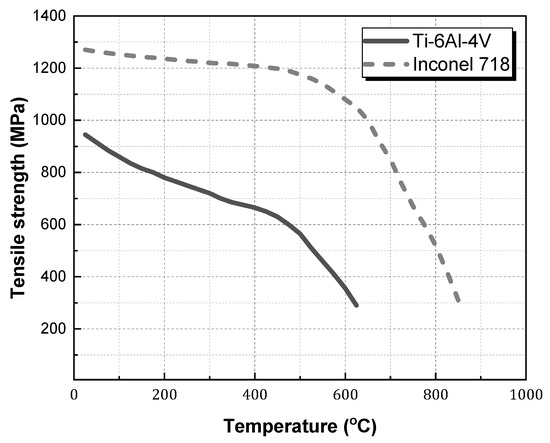
Figure 1.
Tensile strength of two materials in dependence on material temperature.
Titanium alloys have high strength, low thermal conductivity, and high chemical reactivity. These characteristics can cause low surface quality, high stress at the tool edges, and a strong chemical affinity to the cutting tool materials, resulting in built-up edge formation [6]. The most common titanium alloy is Ti-6Al-4V, which belongs to the + alloy group and accounts for more than 50% of titanium alloy production. It offers high strength, depth hardenability, and elevated temperature properties up to 400 °C [7]. In general, dry or conventional coolant flow conditions are not recommended for machining titanium alloy because of their poor performance due to excessive wear rates. The reduction in hot hardness under elevated temperature conditions leads to the weakening of the interparticle bond strength [8]. Conventional machining of Ti-6Al-4V is a highly difficult process that exhibits high cutting force and low surface quality—a behavior that causes major damage to the cutting tool and increases cutting energy. This report is concerned with describing the effect of heat assistance through a comparative experiment.
Studies on laser-assisted machining of titanium alloys have been performed by several researchers. Brecher et al. [9] developed an optical and mechanical system of a novel approach for laser-assisted milling. All laser components, the spindle, and the cutting tool were assembled and integrated into a 5-axis machining center with combined real-time control provided for the laser-assisted machining. Yang et al. [4] conducted an experimental investigation of the effects of a laser heat source during the laser-assisted machining of Ti-6Al-4V alloy. The study focused on the characterization and prediction of heat-affected zones caused by the process of laser-heating Ti-6Al-4V alloy, and a 3D thermal model for a moving Gaussian laser beam was developed to predict the temperatures generated in the workpiece. Sim and Lee [10] studied the machining characteristics according to the inclination angle of the titanium alloy workpiece in laser-assisted milling. The optimal laser power was obtained through thermal analysis and preheating experiments. Oh et al. [11] studied the cutting force and specific cutting energy in laser-assisted trochoidal milling of Ti-6Al-4V. The process efficiency of the trochoidal milling was analyzed and verified for different machining conditions. Zhai et al. [12] studied the surface heat-affected zone and surface quality of Ti-6Al-4V alloy by laser-assisted micro-cutting. The effects of laser power, cutting speed, and depth of cut on tool wear, surface quality, and residual stress were investigated, with the main focus being on the influence of laser power and cutting speed on the heat-affected zone of the material surface. Kalantari et al. [13] investigated the characteristics of surface integrity in the machining of Ti-6Al-4V alloy with conventional and laser-assisted machining processes. Surface integrity—including microhardness, grain size, and surface roughness, as well as thermal loads generated during the removal process—was evaluated at different machining parameters. Dargusch et al. [14] evaluated a range of coating types on a series of cutting tools that have been used in the machining of titanium alloys. Several coated carbide tools were tested during conventional and laser-assisted milling. They provided insight into the typical limitations of current cutting tools and highlighted the need for new and improved cutting tools suitable for application in laser-assisted machining. Feng et al. [15] proposed an analytical predictive model for residual stress in laser-assisted milling, considering material recrystallization caused by laser preheating. The model was validated through experimental measurements on the laser-assisted milling of Si4N4 and Ti-6Al-4V. It matched the trends in experimental measurements, with the agreement to an average error of less than 30% in all cases. In another study by Feng et al. [16], an analytical predictive model for temperature in laser-assisted milling was proposed, which considered both laser preheating temperature and a machining-induced temperature rise. The model was validated through experimental measurements on silicon nitride ceramics and Ti-6Al-4V alloy, and it could effectively provide a fast, credible, and physics-based method for the prediction of temperature in the laser-assisted milling of various materials. Hourmand et al. [17] reviewed and discussed the impact of machining inputs on the machining force, chip formation, cutting temperature, tool wear, mechanical properties, and surface integrity during turning and milling of titanium (Ti) alloys. Moreover, laser-assisted machining, ultrasonically assisted machining, and different cooling systems were reviewed. These techniques can significantly improve Ti alloys’ machinability. They can improve the surface integrity, tool life, and mechanical properties, as well as reducing machining force and cutting temperature. Pimenov et al. [18] reviewed an extensive analysis of the literature on such cooling techniques as dry, conventional cooling systems, a minimum quantity of lubricant, a minimum quantity of cooling lubrication, cryogenic lubrication, and high-pressure cooling. They showed how the type of cooling affects the surface integrity, including surface roughness, tool wear, tool life, temperature, cutting forces, environmental aspects, etc. The main advantages, disadvantages, and prospects of different cooling methods were also demonstrated. Vora et al. [19] performed the optimization of the fiber laser-cutting process of Ti-6Al-4V using the Taguchi method. Laser power, cutting speed, and gas pressure were selected as input process parameters, whereas surface roughness, kerf width, dross height, and material removal rate were considered output variables. Bharat and Bose [20] studied the consequences of machining process parameters during the machining of hard-to-cut materials using the laser-assisted machining method. Laser-assisted machining has increased productivity as well as efficiency of hard-to-cut materials compared to the traditional machining methods. Mruthunjaya and Yogesha [21] reviewed the conventional and thermal-assisted machining of titanium-based alloys. Thermal-assisted machining is associated with a higher material removal rate, higher surface finish, and better control of time on machining. It helps in reducing cutting forces, thereby increasing surface finish. Luan et al. [22] investigated the machining characteristics of Ti-6Al-4V alloy in laser-assisted machining under minimum quantity lubricant (MQL). The results showed that, compared with dry cutting, laser-assisted machining with MQL, the tool wear, chip shape, and surface quality of the laser-assisted machining with MQL were significantly improved.
Many researchers studied the feasibility of laser-assisted machining of titanium alloys. However, there are still some issues with inefficient laser heating techniques, poor process control without any temperature control, and insufficient machinability benefits. Laser-assisted machining has been characterized in terms of various heating and operating conditions. Experiments should be conducted in various environments to obtain the practical data required by the industry. Our research presents an experimental study of the machinability of titanium alloys by the laser-assisted end milling process. The purpose of this work is to verify the effects of laser heat assistance through comparative experimentation and to obtain practical data. In Section 2, the absorptivity of Ti-6Al-4V with a 1 kW high-power diode laser is calculated and the prediction of laser preheating temperature distribution is presented and verified. In Section 3, machined surface quality and tool wear are evaluated during machining with laser beam assistance. The effects of the machining variables, such as spindle speed, feed rate, and depth of cut on cutting force, are also discussed.
2. Material and Methods
2.1. Experimental Set-Up
Figure 2 shows a schematic diagram of the laser-assisted end milling process. A laser heat source locally preheats the material in front of the cutting tool path, effectively heating only the volume of the material to be machined. Melting or vaporization can be caused on the workpiece surface by high-temperature heating. These affected areas are then machined by the cutting tool during the laser-assisted end milling process. The laser heat source has a square shape, with one side being 6 mm in length. A homogenizer (Laserline GmbH, Mülheim-Kärlich, Germany) is installed on the lens of the laser head to change the heat source shape from a circle into a square. The laser beam has a top-hat shape. The input heat per unit area applied to the beam irradiation surface is constant and the irradiation mechanism and structure are simple compared with other laser systems.
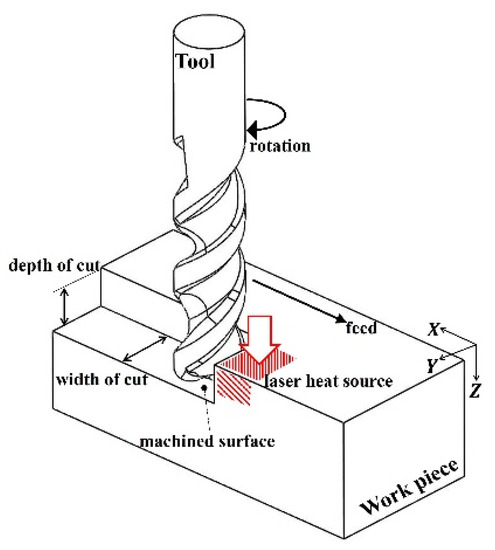
Figure 2.
Schematic diagram of laser-assisted end milling process.
The laser-assisted end milling system and its details are shown in Figure 3. The system was installed in a 5-axes CNC machine tool with a 1 kW high-power diode laser module. The wavelength range of the laser module was 940–980 nm. During our investigation, we used the lens with 100 mm focal length in the laser module. The working distance of this lens was 90 mm. Cutting tools by the commercial products (WIDIN Co., Ltd., Changwon, Korea) were used. The tool had a diameter of 6 mm, a helix angle of 30 degrees, 4 flutes, and a length of 100 mm. A standard coolant was not used for any of the experiments.
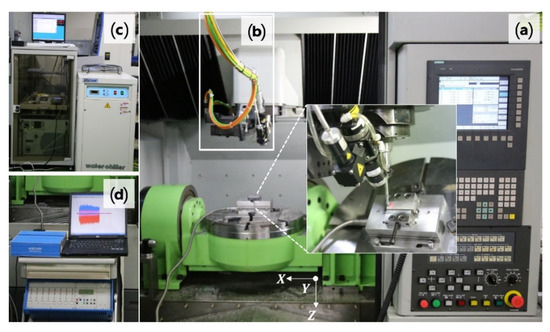
Figure 3.
Experimental set-up: (a) CNC milling machine; (b) fiber-coupled high-power diode laser; (c) laser controller; (d) dynamometer.
2.2. Workpiece Material and Absorptivity
The workpiece material used in all the experiments was a bar of Ti-6Al-4V titanium alloy. The chemical compositions of the material (in wt.%) are given in Table 1 [4].

Table 1.
Chemical composition of titanium alloy as mass percentage.
Absorption rate is a significant factor during laser processing, affecting process efficiency, and reliability. It can vary according to the type of laser and the wavelength of the laser [2,4]. This author has calculated the absorptivity of Ti-6Al-4V in a previous study [23]. The absorptivity of Ti-6Al-4V was determined through heating experiments using a laser. A laser beam of constant power was radiated to the workpiece sample, and the surface temperature of the workpiece was subsequently measured. The absorptivity was calculated using Equation (1) [24] as
where , , , , and are the weight of the workpiece, specific heat, temperature rise, laser power, and heating time of the laser, respectively. Figure 4 shows the results of absorptivity for Ti-6Al-4V. Based on these results, the absorptivity for all experiments in this work was applied according to temperature.
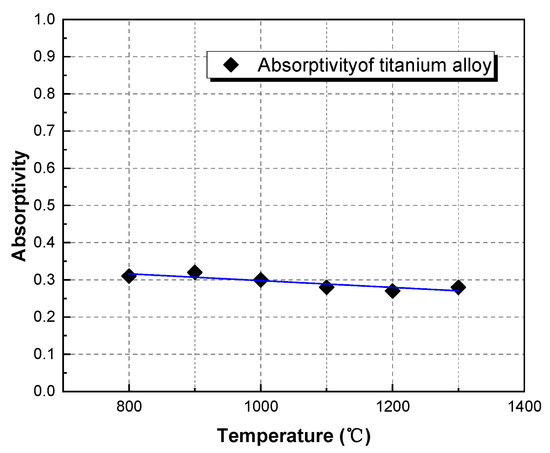
Figure 4.
The results of absorptivity versus temperature behavior of the Ti-6Al-4V workpiece sample.
2.3. Thermal Analysis
A preheating temperature and an effective depth of cut should be determined based on the thermal characteristics of the workpiece material. To predict temperature distribution and depth of cut, a thermal analysis was performed.
The thermal analysis by temperature-dependent inputs is described by Equation (2) [25] as
where , , , and are the density of the material, specific heat, thermal conductivity, and power per unit volume, respectively.
The initial condition at time is given by Equation (3) as follows:
The boundary conditions can be defined by Equation (4) as
where , , , and are the heat flux, heat transfer coefficient, surface temperature, and ambient temperature, respectively.
Figure 5 shows the thermal properties of Ti-6Al-4V as a function of temperature. The density of Ti-6Al-4V is listed in Table 2 [26].

Figure 5.
Thermal properties of Ti-6Al-4V as a function of temperature.

Table 2.
The density of Ti-6Al-4V.
The tensile strength of Ti-6Al-4V decreases significantly at temperatures above approximately 600 °C. Accordingly, the temperature range for effective machining is 500–620 °C, as shown in Figure 1. The finite element model was composed using the finite element analysis package ANSYS Workbench. A hexagonal mesh was employed in the analysis model. The model included 85,926 nodes and 19,500 elements. The mesh size was divided by 1 mm. The boundary condition in natural convection of 5 W/m2k was used on all surfaces. The feed rate of the heat source, which had a square shape and length of 6 mm, was 150 mm/min. The laser power was applied to 80 W in the heated zone.
In the analysis results (Figure 6), the surface temperature was about 618 °C. The depth of cut was determined as 0.3, 0.5, and 0.7 mm, respectively, in accordance with the depth that was heated to a temperature of up to 500 °C, where the tensile strength sharply decreased.
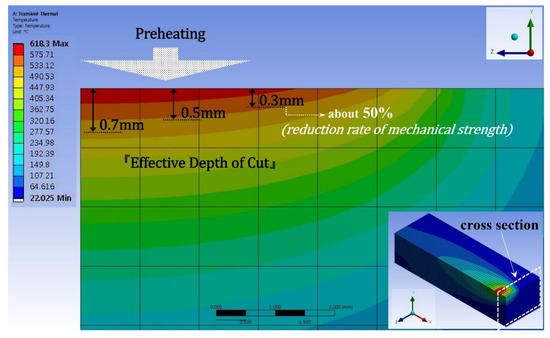
Figure 6.
The results of the thermal analysis.
Validation of the thermal model was conducted by measuring the temperature of the laser-irradiated workpiece surface using a pyrometer (Dr. Mergenthaler GmbH & Co. KG, Neu-Ulm, Germany). The measurement point, which is the surface of the workpiece, is preheated by the laser heat source. There was a good agreement between the measured and simulated data, as shown in Figure 7.

Figure 7.
Surface temperature histories of experiment and simulation.
3. Results and Discussion
3.1. Experiment
Table 3 shows the parameters and levels used to perform the experiments. Experiments were performed with 12 runs in random order, as listed in Table 4. A flat end milling process was performed. In each machining test, the cutting length was 60 mm. A temperature control function—where the desired heating temperature was maintained by automatically controlling the laser power using the pyrometer—was applied during experiments. The workpiece was preheated with precision by the function of the laser module. Surface roughness, cutting force, and tool wear were all measured.

Table 3.
Parameters and levels used in the experiments.

Table 4.
Experimental order and results.
3.2. Surface Roughness and Cutting Tool Damage
Two methods were used for the experiments: conventional end milling without laser beam assistance and laser-assisted end milling. Figure 8 shows the results of surface roughness measurements. Surface roughness was expressed by the centerline average height, . The measurement length was 4 mm on the machined surface of the workpiece and the measurement speed was 0.2 mm/s. A Gaussian profile filter was used for the analysis of surface roughness. A cut-off value of 0.25 mm was used in this experiment. For reliable results, the average values of three experimental iterations under the same conditions were used. The surface roughness decreased from the laser-assisted end milling compared to the results of conventional end milling in all cases. When laser heating was used, the surface quality improved because the cutting resistance decreased from the laser heating, which softened the material prior to machining.
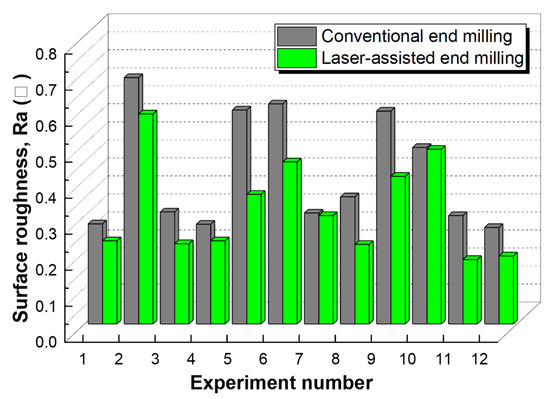
Figure 8.
Results of surface roughness measurements.
Figure 9 shows the microphotograph of the machined surface. The result of the quality of the machined surfaces was shown to be similar to the measured surface roughness. The surface quality was improved by the laser-assisted end milling compared to the results of conventional end milling.
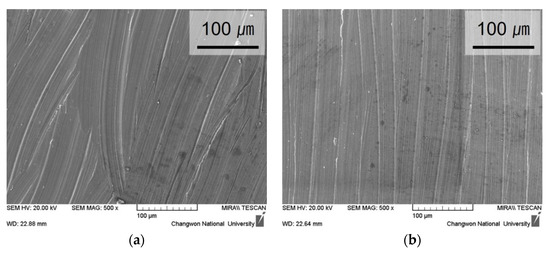
Figure 9.
Microphotographs of machined surfaces: (a) conventional end milling; (b) laser-assisted end milling (spindle speed: 5000 RPM, feed rate: 200 mm/min, depth of cut: 0.7 mm).
Cutting tool wear measurements were performed. Figure 10 shows the tool used in the experiment under certain machining conditions. In the case of conventional end milling, the tool was damaged after machining, and edge fracture and chip adhesion occurred. In contrast, laser-assisted end milling was better than conventional milling in terms of cutting tool damage. The fact that cutting tool life can be improved by using laser-assisted machining is not well defined. It is clear that the tool life is evaluated by specific conditions of cutting parameters, laser parameters, cutting tool type, and material. In some cases, a cutting tool’s life may be decreased by the excessive heat effect.

Figure 10.
Microphotographs of the used cutting tool in experiment: (a) conventional end milling; (b) laser-assisted end milling (spindle speed: 5000 RPM, feed rate: 200 mm/min, depth of cut: 0.7 mm).
3.3. Influence of Machining Parameters on Cutting Force Reduction
Cutting force data were measured using a dynamometer (Kistler, Winterthur, Switzerland) and a charge amplifier (Kistler, Winterthur, Switzerland). The output data from the charge amplifier were presented on a computer using a software package. The cutting force was used as the main cutting force value in the direction of the cutting speed. An average cutting force during the total machining time was used because the feed rate, depth of cut, and spindle speed were maintained during the machining process. In this section, the effects of the feed rate, depth of cut, spindle speed, and cutting force were studied by three sets of comparative experiments, and the effects of conventional end milling and laser-assisted end milling on cutting forces were compared.
Figure 11, Figure 12 and Figure 13 represent the trend in the changed cutting forces obtained by changing the feed rate, depth of cut, and spindle speed under the conditions of conventional end milling and end milling with laser assistance. It is clear that heat assistance significantly influences the magnitude of the cutting forces. In all cases of laser-assisted end milling, the cutting forces decreased when compared with conventional end milling. The actual reduction in forces varied slightly depending on the force component, cutting tool, and cutting conditions; however, force components did reduce in the range of about 13–46%. This coincides with other literature in the field [9,11,14,17], which suggests that force reductions between 15–50% can occur during laser-assisted machining of titanium alloys.
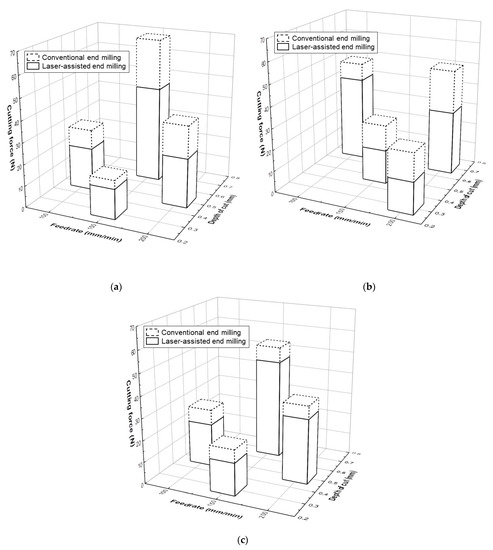
Figure 11.
Effect of federate (100, 150, 200 mm/min) and depth of cut (0.3, 0.5, 0.7 mm) parameters on cutting forces: (a) at spindle speed of 7000 RPM; (b) at spindle speed of 5000 RPM; (c) at spindle speed of 3000 RPM.
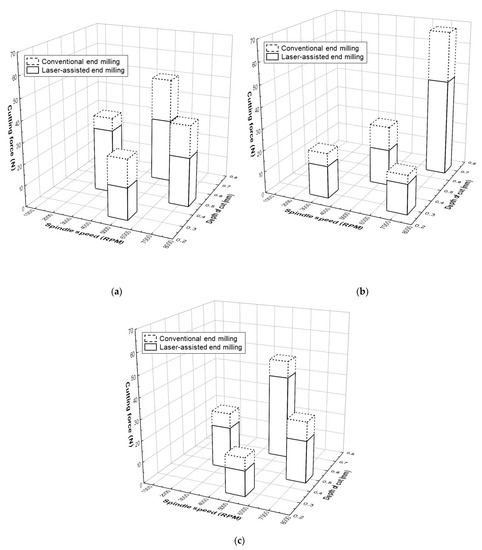
Figure 12.
Effect of spindle speed (3000, 5000, 7000 RPM) and depth of cut (0.3, 0.5, 0.7 mm) parameters on cutting forces: (a) at feed rate of 200 mm/min; (b) at feed rate of 150 mm/min; (c) at feed rate of 100 mm/min.
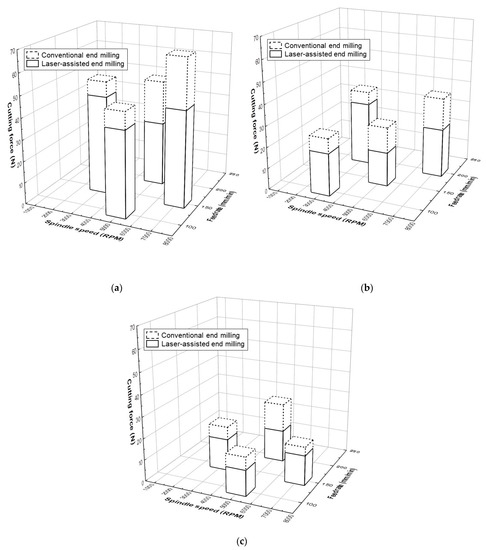
Figure 13.
Effect of spindle speed (3000, 5000, 7000 RPM) and federate (100, 150, 200 mm/min) parameters on cutting forces: (a) at depth of cut of 0.7 mm; (b) at depth of cut of 0.5 mm; (c) at depth of cut of 0.3 mm.
In Figure 11, the cutting force was decreased by about 46% at 5000 RPM of spindle speed, 200 mm/min of feed rate, and 0.3 mm of depth of cut. When the depth of cut was increased for the machining of titanium alloy, spindle speed should have been reduced. When the feed rate was low, the cutting force showed a decreasing trend in the relationship between spindle speed and depth of cut, as shown in Figure 12.
Figure 13 shows that depth of cut has a significant effect on cutting force. When the feed rate increased, the cutting force also increased. However, the effect of the laser assistance was better. This can be explained by the fact that, when the feed rate is high, the preheating effect of the laser heat source is small, and the strength reduction in the material is not obvious.
4. Conclusions
In this work, Ti-6Al-4V titanium alloy was machined by laser-assisted end milling under different machining conditions. The conclusions of this work are summarized as follows:
- The absorptivity of Ti-6Al-4V titanium alloy was calculated by conducting heating experiments. The absorptivity was approximately 0.3 by the high-power diode laser.
- The 3D transient analysis model was established. The depth of cut was selected through thermal analysis results, in consideration with the depth that was heated to a temperature of up to 500 °C, where the tensile strength sharply decreased.
- The experiments were performed with conventional machining and laser-assisted machining. Surface roughness, tool wear, and cutting force were evaluated.
- The surface roughness was improved by the laser-assisted end milling compared to the results of conventional end milling in all cases. Additionally, the cutting tool wears were measured. It was confirmed that laser-assisted end milling was better than conventional milling in terms of cutting tool damage. The fact that a cutting tool’s life can be extended by using laser-assisted machining is not well defined. The tool’s life is evaluated by specific conditions of cutting parameters, laser parameters, cutting tool type, and material.
- Laser-assisted end milling reduced the cutting forces in line with increasing preheated workpiece temperatures. Reduction in the cutting force of up to 49% was achieved at 5000 RPM of spindle speed, 200 mm/min of feed rate, and 0.3 mm of depth of cut.
5. Future Research Perspectives
- Three-dimensional laser-assisted milling of workpieces with complicated shapes is needed to apply products to industry fields. However, it is highly challenging to control cutting tool axes and laser module axes simultaneously. Therefore, a control method should be developed to effectively machine a complex tool path.
- Damage to the cutting tool can be caused by a high-temperature heat source, which can decrease accuracy and increase costs. Therefore, a new cutting tool should be developed with heat resistance and hardness in mind.
- More studies are necessary to determine the optimum machining conditions in laser-assisted milling. Various factors affecting machining, including machining parameters, type of laser, and material characteristics, should be considered simultaneously.
Author Contributions
Conceptualization, D.-H.K.; methodology, D.-H.K.; software, D.-H.K.; validation, D.-H.K.; formal analysis, D.-H.K.; investigation, D.-H.K.; resources, D.-H.K.; data curation, D.-H.K.; writing—original draft preparation, D.-H.K.; visualization, D.-H.K.; writing—review and editing, C.-M.L.; supervision, C.-M.L.; project administration, D.-H.K. and C.-M.L.; funding acquisition, C.-M.L. All authors have read and agreed to the published version of the manuscript.
Funding
This work was supported by the National Research Foundation of Korea (NRF) grant funded by the Korea government (MSIT) (No. 2019R1A2B5B03070206).
Institutional Review Board Statement
Not applicable.
Informed Consent Statement
Not applicable.
Data Availability Statement
Data are contained within the article.
Conflicts of Interest
The authors declare no conflict of interest.
Nomenclature
| Symbol | Name | Unit |
| A | Absorptivity | |
| Weight of the workpiece | g | |
| Specific heat | J/k·kg | |
| Temperature rise | °C | |
| Laser power | W | |
| Heating time of the laser | s | |
| Density | Kg/m3 | |
| Thermal conductivity | W/m·K | |
| Power per unit volume | W/m3 | |
| Heat flux | W/m2 | |
| Heat transfer coefficient | W/(m2K) | |
| Surface temperature | °C | |
| Ambient temperature | °C |
References
- Lee, C.M.; Kim, D.H.; Baek, J.T.; Kim, E.J. Laser Assisted Milling Device: A Review. Int. J. Precis. Eng. Manuf.-Green Technol. 2016, 3, 199–208. [Google Scholar] [CrossRef]
- Kim, D.H.; Lee, C.M. A Study of Cutting Force and Preheating-Temperature Prediction for Laser-Assisted Milling of Inconel 718 and AISI 1045 steel. Int. J. Heat Mass Transf. 2014, 71, 264–274. [Google Scholar] [CrossRef]
- Kim, D.H.; Lee, C.M. A Study on the Laser-Assisted Ball-End Milling of Difficult-to-cut Materials using a New Back-and-forth Preheating Method. Int. J. Adv. Manuf. Technol. 2016, 85, 1825–1834. [Google Scholar] [CrossRef]
- Yang, J.; Sun, S.; Brandt, M.; Yan, W. Experimental Investigation and 3D Finite Element Prediction of the Heat Affected Zone during Laser Assisted Machining of Ti6Al4V Alloy. J. Mater. Process. Technol. 2010, 210, 2215–2222. [Google Scholar] [CrossRef]
- Sun, S.; Brandt, M.; Dargusch, M.S. Thermally Enhanced Machining of Hard-to-machine Materials-A Review. Int. J. Mach. Tools Manuf. 2010, 50, 663–680. [Google Scholar] [CrossRef]
- Che-Haron, C.H.; Jawaid, A. The Effect of Machining on Surface Integrity of Titanium Alloy Ti-6% Al-4%V. J. Mater. Process. Technol. 2005, 166, 188–192. [Google Scholar] [CrossRef]
- Arrazola, P.-J.; Garay, A.; Iriarte, L.-M.; Armendia, M.; Marya, S.; Le Maître, F. Machinability of Titanium Alloys (Ti6Al4V and Ti555.3). J. Mater. Process. Technol. 2009, 209, 2223–2230. [Google Scholar] [CrossRef] [Green Version]
- Ezugwu, E.O.; Da Silva, R.B.; Sales, W.F.; Machado, A.R. Overview of the Machining of Titanium Alloys. Encyclopedia Sustain. Technol. 2017, 2, 487–506. [Google Scholar]
- Brecher, C.; Rosen, C.J.; Emonts, M. Laser-assisted Milling of Advanced Materials. Phys. Procedia 2010, 5, 259–272. [Google Scholar] [CrossRef]
- Sim, M.S.; Lee, C.M. Determination of Optimal Laser Power according to the Tool Path Inclination Angle of a Titanium Alloy Workpiece in Laser-Assisted Machining. Int. J. Adv. Manuf. Technol. 2016, 83, 1717–1724. [Google Scholar] [CrossRef]
- Oh, N.S.; Woo, W.S.; Lee, C.M. A Study on the Machining Characteristics and Energy Efficiency of Ti-6Al-4V in Laser-Assisted Trochoidal Milling. Int. J. Precis. Eng. Manuf.-Green Technol. 2018, 5, 37–45. [Google Scholar] [CrossRef]
- Zhai, C.; Xu, J.; Li, Y.; Hou, Y.; Yuan, S.; Wang, X.; Liu, Q. Study on Surface Heat-Affected Zone and Surface Quality of Ti-6Al-4V Alloy by Laser-Assisted Micro-Cutting. Int. J. Adv. Manuf. Technol. 2020, 109, 2337–2352. [Google Scholar] [CrossRef]
- Kalantari, O.; Jafarian, F.; Fallah, M.M. Comparative Investigation of Surface Integrity in Laser Assisted and Conventional Machining of Ti-6Al-4V alloy. J. Manuf. Process. 2021, 62, 90–98. [Google Scholar] [CrossRef]
- Dargusch, M.S.; Sivarupan, T.; Bermingham, M.; Rashid, R.A.R.; Palanisamy, S.; Sun, S. Challenges in Laser-Assisted Milling of Titanium Alloys. Int. J. Extrem. Manuf. 2021, 3, 015001. [Google Scholar] [CrossRef]
- Feng, Y.; Hung, T.P.; Lu, Y.T.; Lin, Y.F.; Hsu, F.C.; Lin, C.F.; Lu, Y.C.; Liang, S.Y. Residual Stress Prediction in Laser-Assisted Milling considering Recrystallization Effects. Int. J. Adv. Manuf. Technol. 2019, 102, 393–402. [Google Scholar] [CrossRef]
- Feng, Y.; Hung, T.P.; Lu, Y.T.; Lin, Y.F.; Hsu, F.C.; Lin, C.F.; Lu, Y.C.; Liang, S.Y. Analytical Prediction of Temperature in Laser-Assisted Milling with Laser Preheating and Machining Effects. Int. J. Adv. Manuf. Technol. 2019, 100, 3185–3195. [Google Scholar] [CrossRef]
- Hourmand, M.; Sarhan, A.A.D.; Sayuti, M.; Hamdi, M. A Comprehensive Review on Machining of Titanium Alloys. Arab. J. Sci. Eng. 2021, 46, 7087–7123. [Google Scholar] [CrossRef]
- Pimenov, D.Y.; Mia, M.; Gupta, M.K.; Machado, A.R.; Tomaz, I.V.; Sarikaya, M.; Wojciechowski, S.; Mikolajczyk, T.; Kaplonek, W. Improvement of Machinability of Ti and its Alloys using Cooling-Lubrication Techniques: A Review and Future Prospect. J. Mater. Res. Technol-JMRT. 2021, 11, 719–753. [Google Scholar] [CrossRef]
- Vora, J.; Chaudhari, R.; Patel, C.; Pimenov, D.Y.; Patel, V.K.; Giasin, K.; Sharma, S. Experimental Investigations and Pareto Optimization of Fiber Laser Cutting Process of Ti6AL4V. Metals 2021, 11, 1461. [Google Scholar] [CrossRef]
- Bharat, N.; Bose, P.S.C. An Overview on Machinability of Hard to cut Materials using Laser Assisted Machining. Mater. Today Proc. 2021, 43, 665–672. [Google Scholar] [CrossRef]
- Mruthunjaya, M.; Yogesha, K.B. A Review on Conventional and Thermal Assisted Machining of Titanium Based Alloy. Mater. Today Proc. 2021, 46, 8466–8472. [Google Scholar] [CrossRef]
- Luan, X.; Meng, J.; Huang, B.; Dong, X.; Hu, Y.; Zhao, Y.; Zhang, H.; Qu, L. Machining Characteristics of Ti6Al4V alloy in Laser-Assisted Machining under Minimum Quantity Lubricant. Int. J. Adv. Manuf. Technol. 2021, 112, 775–785. [Google Scholar] [CrossRef]
- Kim, D.H.; Lee, C.M. A Fundamental Study on the Absorptivity of Diode laser for Titanium Alloy. In Proceedings of the KSMTE Spring Conference, Busan, Korea, 25–26 April 2013; p. 235. [Google Scholar]
- Kim, D.H. Laser Processing; revised edition; Kyungmoon Publishers: Seoul, Korea, 2005; pp. 208–219. [Google Scholar]
- Incropera, F.P.; Dewitt, D.P.; Bergman, T.L.; Lavine, A.S. Fundamentals of Heat and Mass Transfer, 6th ed.; John Wiley & Sons: Hoboken, NJ, USA, 2007; pp. 70–95. [Google Scholar]
- Mills, K.C. Recommended Values of Thermophysical Properties for Selected Commercial Alloys, 1st ed.; Antony Rowe Ltd.: Wiltshire, UK, 2002; p. 217. [Google Scholar]
Publisher’s Note: MDPI stays neutral with regard to jurisdictional claims in published maps and institutional affiliations. |
© 2021 by the authors. Licensee MDPI, Basel, Switzerland. This article is an open access article distributed under the terms and conditions of the Creative Commons Attribution (CC BY) license (https://creativecommons.org/licenses/by/4.0/).